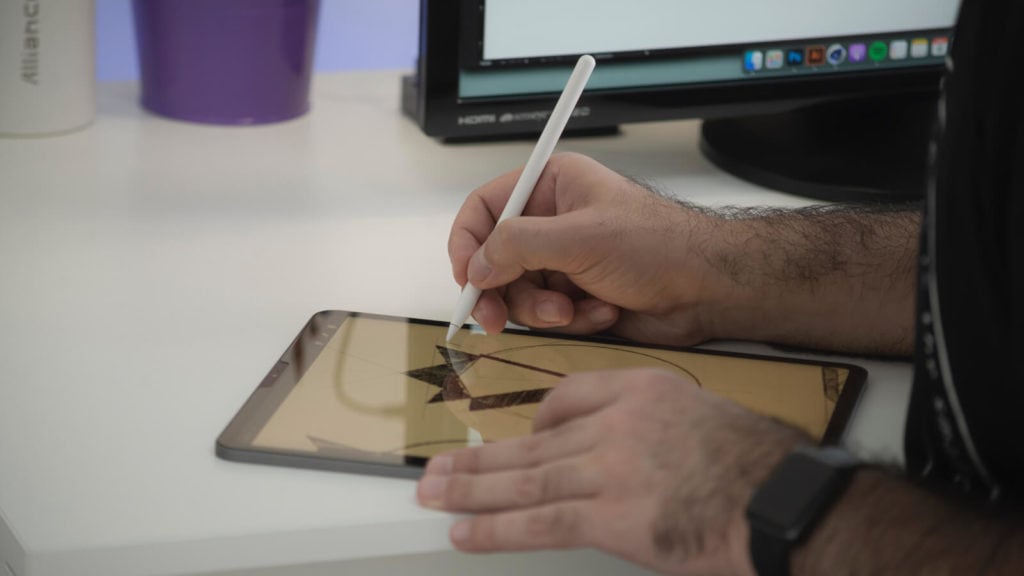A logo is the key element in building a strong brand identity. In fact, a report reveals that 75% of consumers can recognize a brand simply by its logo.
However, creating a logo that truly captures the essence of your client’s business can be a challenging task. This post will show you how to create an effective logo design questionnaire with sample questions and templates.
But before we get into that, let’s define some basic concepts.
| Short on time? Go straight to the questionnaire template. |
What is a logo?

A logo is a symbol that represents a company, brand, organization, or product.
More often than not, it’s the first visual element that people associate with a business — just think of brands like Apple or Nike.
That’s why logos are essential brand elements for every business. A logo differentiates you from competitors and instantly conveys a message about the quality and nature of your brand.
Why a logo matters
A great logo sets a business apart and can create intrigue or curiosity. In order to effectively create a logo you first need to understand what makes a business unique and where they are at in terms of their brand development.
It pays to work on the brand first because the brand values will inform the development of a quality logo. Depending on what the requirements are, you may need a logo brief from the client as well as a more general creative brief or questionnaire.
| Pro tip: Tools like Content Snare can streamline brand discovery by securely collecting brand guidelines, values, and other critical inputs during client onboarding. |
What is a logo design questionnaire
A logo design questionnaire is a series of questions your clients answer to give you an understanding about their logo preferences and may also give you an indication of how they may be to work with as a client.
The logo requirements and project scope will become clear with the answers to this questionnaire. You may be working with them on establishing a new logo or refreshing an old one or you may need to work with them on their overall brand.
A logo questionnaire is closely related to a branding questionnaire, only it is more about one aspect of the business branding and not the entire brand.
It could be that a new brand strategy has been developed already and the logo design project is the next item on the list alongside other design collateral.
A typical initial logo assessment (particularly if it’s just the logo that needs to be done) asks about:
- Goals and objectives
- Target audience and clients
- Products and services
- Main competitors
- Design preferences
- Unique selling proposition (what makes them different)
- Budget
If clients are looking to rebrand, you can also ask about:
- Any issues or problems they’ve bumped up against with the current brand/logo
- Who they want to be perceived as in the market
- What colour/visual guidelines, preferences or constraints they have
- Do they have a specific idea on how to emphasize their unique brand identity
Other common types of questionnaires you could use:
- Website design questionnaire
- Client onboarding questionnaire
- SEO questionnaire
- Social media questionnaire
Why create a logo design questionnaire template?

A logo questionnaire template helps you work with clients when developing their logo. It’s a tool to gather information for the logo design process. The questionnaire can include questions about:
- The client's target audience
- Brand values and mission
- Your client’s preferred color scheme
- Brand attributes and overall style preferences
Now that we know this, we’re going to look at how to construct a logo design questionnaire template to help your customers brief you on their logo requirements.
Questions to ask when designing a logo

Now you know the why, what and how of creating a logo design questionnaire, let’s dive into the questions for your form. So, what questions should you ask when designing a logo?
Your logo intake form's length depends on your business strategy. If you’re trying to do lots of projects at a lower price, you might want to get all the info for their logo and branding upfront.
If you are doing higher-priced logo design projects where you include brand strategy discussions, the questionnaire might just be an initial filter to weed out low value clients and (or) to give you enough info for an in-person meeting.
Here are our favourite questions and why we ask them.
Note
Screenshots are taken from Content Snare’s Logo Design Questionnaire.
1. How did you find out about us?
This is a great question to ask for two main reasons:
- It could highlight a marketing channel you’d never considered before
- If they give you someone’s name, you can surprise that person with a special reward or treat (referrals are great and should be rewarded or acknowledged)
2. Do you have current brand guidelines?
This question gives you an idea of where the client is at right now so you can gauge how much work is required.
It’s also an upsell opportunity if they want help with their overall brand redevelopment or their other brand collateral. Here are some example answers:
- Yes, they’re attached/available here: [URL]
- Nope, but I will be putting them together
- Nope, and I need help with them
3. What are your products and services

This is an obvious question but an essential one.
Don’t assume you know what the business does. Don’t assume the client can articulate it perfectly either.
Sometimes a little more clarity and guidance is needed before you can design a logo to represent the brand well.
4. Who are your ideal customers?
This question is to gain an understanding of the audience. If they don’t know, this may also be an opportunity to upsell customer avatar development. Knowing the ideal customer profile is critical to logo design.
5. If your logo is a success, what would that result in?
This enables you to pinpoint what results the client is after with logo creation.
6. If your logo was a superhero, what would be its superpowers?
This is a fun way to find out how the business would describe its strengths and assets. It gives you additional info about the preferred logo style, which can simplify your creative process.
7. What emotions/attributes do you want your logo to convey?

Building a dream logo also means capturing the true emotion of a brand. Here’s just a couple of nice examples:
- A food brand may go for “freshness, zest and colour”
- A tool hardware store may go for “strength and reliability”
8. Who are your top 3 competitors and how do you differ from them?
Understanding the competition and how they brand themselves is vital to creating a unique logo that stands out from the crowd.
9. List 3 logos you like and include dot points what you do and don’t like for each
It’s important to find out what their preferences are.
So many times they say they like a logo, but it turns out they only like one aspect of the logo i.e. the colours and hate the rest of it.
If you based your logo design on that, you’re in trouble. It’s better to find out what they like and don’t like early on in the process.
10. Do you have an idea for your new logo?

Some clients have quite fixed ideas on what they want before they come to you. It’s good to get clear on this at the outset. Sometimes the idea they have won’t align with their vision for the brand and you may need to have further conversations about it.
11. Do you have colour and font preferences for your logo?
Most people have pretty strong colour preferences, and they can often give you directions for other logo elements as well. Knowing this will save you time and headaches while you’re developing ideas.
12. Will your logo include a tag line? If so, will it always appear with the logo?
The tag line may be important to the logo, so it’s good to know if you need to incorporate it into your design ideas.
13. What is your budget?
This is the ultimate filter.
We suggest a dropdown list where the smallest amount is “<$2000”.
Generally, you’d set the bottom level as the budget you don’t want to work with and may simply refer them to someone else if they select this option.
14. What is your timeframe?

This question will weed out potential clients that want everything yesterday.
Including this question helps you prioritize your work schedule or decide whether or not you have the capacity to take on the job.
Why is it so important to get the logo questionnaire right?
We briefly mentioned some advantages of making a questionnaire form, but there are a few very specific benefits you should be aware of.
Benefit #1 – Avoiding project failure
A good logo questionnaire helps ensure that your design isn’t a massive fail. Simple as that.
A logo brief is like a roadmap for you as a designer. It highlights what’s important to the client, so you can get all the project details right.
Related: How this agency saved time and frustration by collecting their content in one place
Benefit #2 – Easier sales
It is way easier to sell to a client that tells you what they are out to achieve and what their preferences are. If you know your client’s vision, you are much more likely to seal the deal.
Benefit #3 – Filtering bad clients
You’ll get a sense of how organized and clear your prospective clients are with this questionnaire. Do they need a new brand? Are they disorganized and unclear in their communication?
You can tease all of this out in your logo questionnaire.
They may be rushing things and that may not bode well for you, or they may take ages to get back to you, giving you an indication that this may be how they approach the project when you get started.
Benefit #4 – Setting cost expectations
A logo questionnaire will also establish the client’s budget expectations. If it’s clear they need their brand redeveloped before they work with you on a logo, this is the time to raise this with the client.
If they have unrealistic expectations in terms of pricing, you may want to refer them to someone else who may be a better fit.
Create your logo questionnaire with Content Snare

A questionnaire is just a kind of form, so you’ll need an online form builder to make it work.
There are so many tools you can use to build your logo questionnaire, but we recommend our own platform: Content Snare.
Our tool helps you avoid unnecessary printing and automate your processes. Content Snare allows your clients to fill answers out in their own time. If they don’t do it in one sitting, they can click their link anytime to come back and resume filling it out.
To ensure they don’t forget, it automatically reminds them until they’ve completed the form. This results in more people completing your logo design questionnaire.

But Content Snare helps with much more.
It streamlines content collection with in-form conversations, automated reminders, approvals/rejections, and many other advanced features. This helps you save time, complete more projects, and get paid faster.Businesses that use Content Snare see a 71% reduction in time spent gathering information and a 77% reduction in data collection costs — making it one of the most efficient tools for creative agencies and branding professionals.

